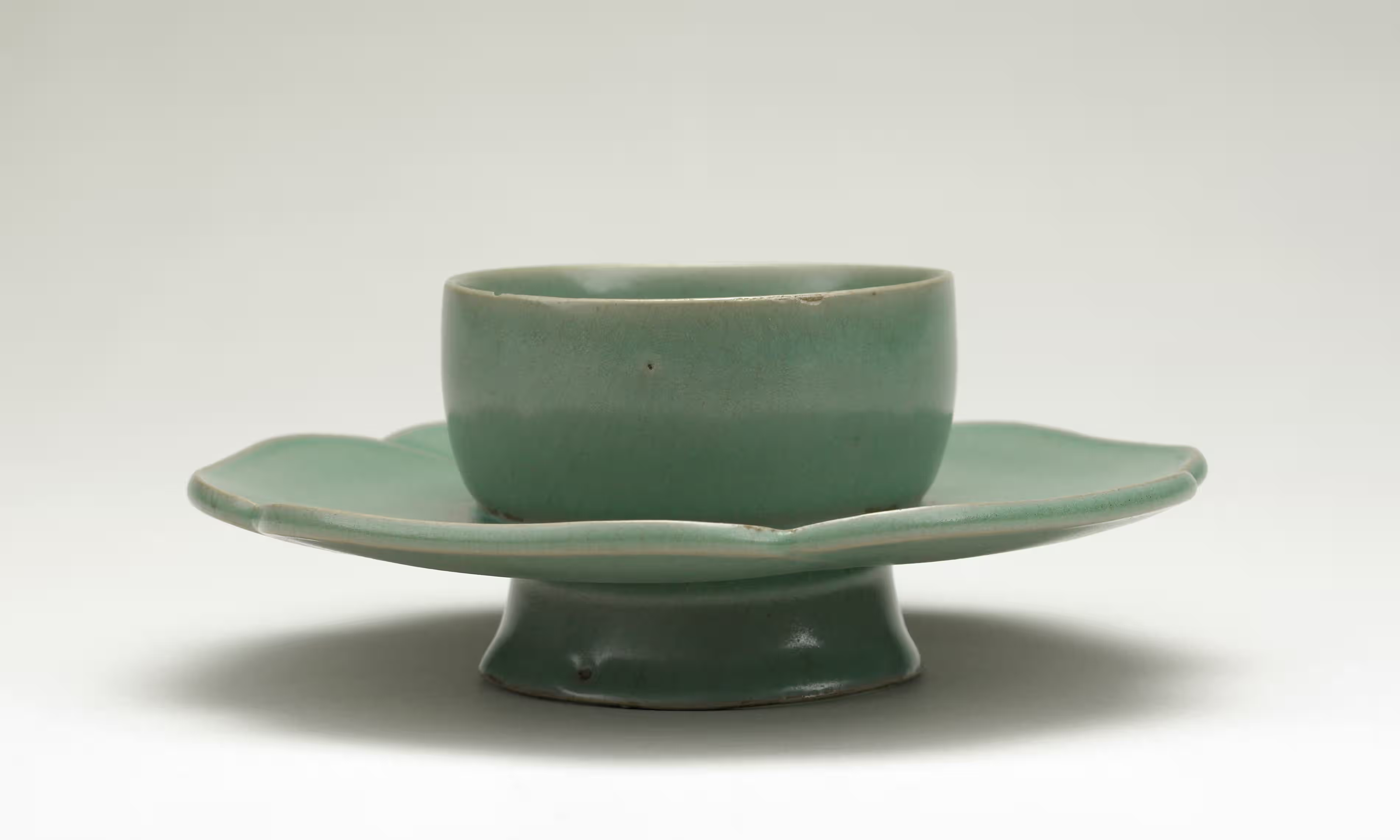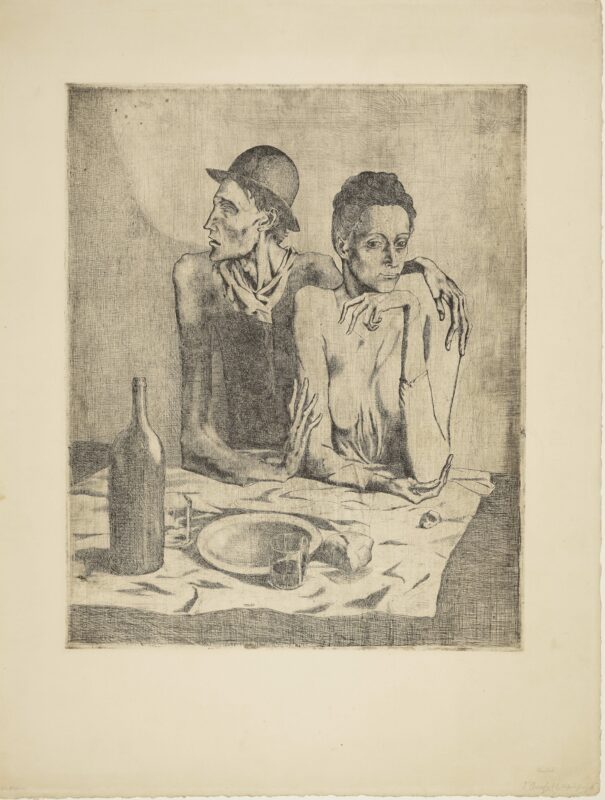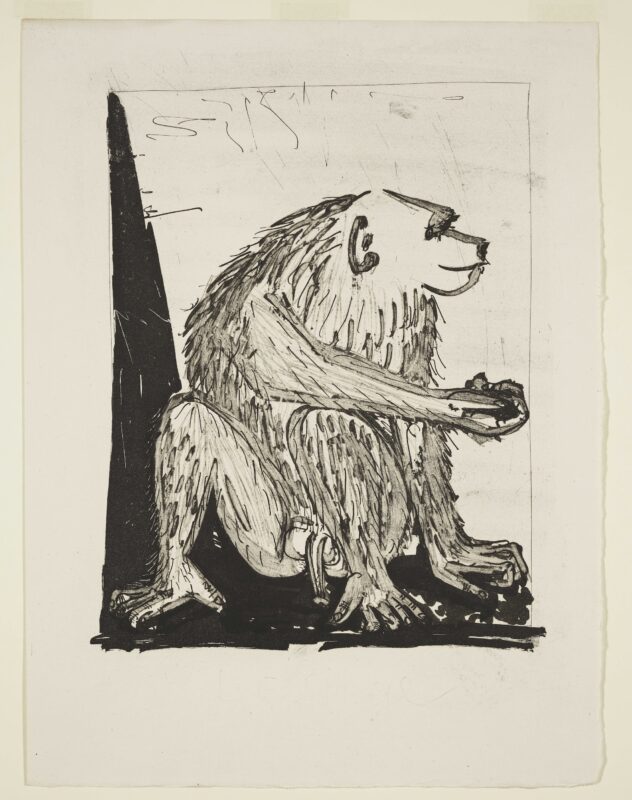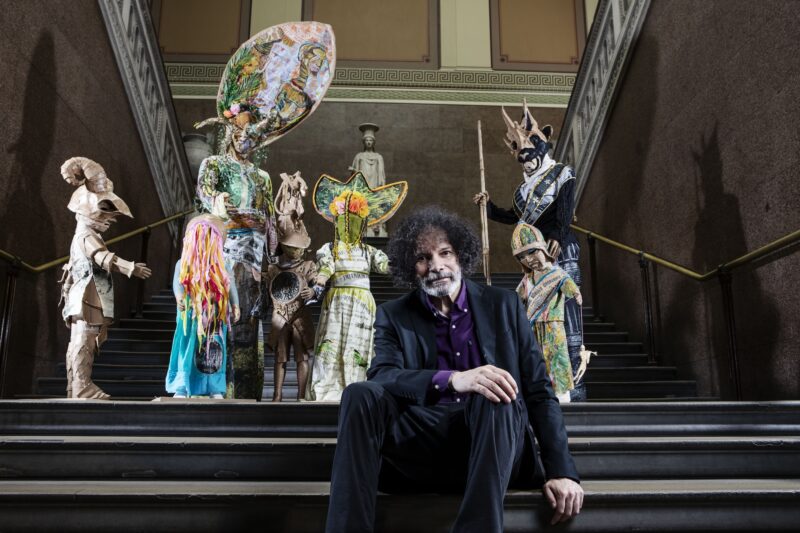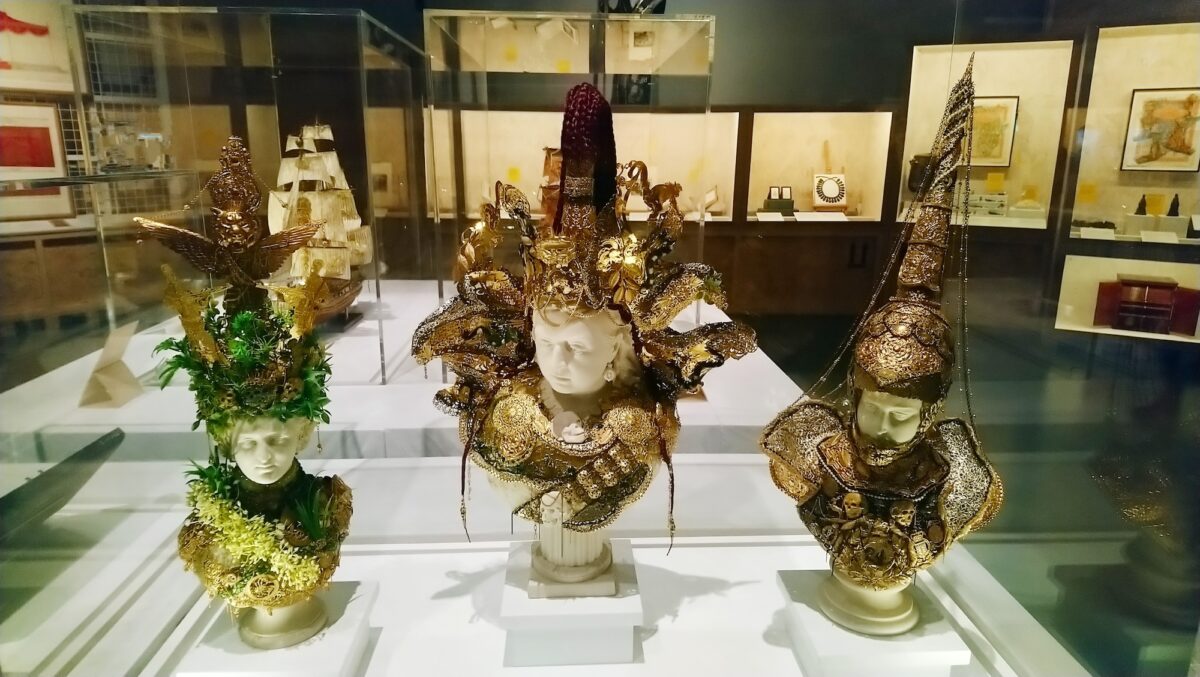
There are close to a hundred rooms at the British Museum, grouped by region and period and filled with objects sorted according to type or function. Set apart from the main collection and reached via a set of stairs, a new major exhibition is presented in packing crates and on metal storage racks in a rather small, dimly lit room above the Reading Room in the museum’s courtyard. Entering the exhibition is like stumbling upon a hidden chamber, almost expecting a layer of dust on the cases or for the figures on the shelves to spring to life. A true chamber of wonder – what have we here?!
Hew Locke has been visiting the British Museum for more than 40 years and spent the last two working behind the scenes with access to objects kept in archive and study rooms. The result is a carefully curated selection of museum objects shown alongside artworks they have inspired and informed. Locke encourages viewers to consider these objects in a revised context. Grouped around a portrait of Queen Victoria and the East India Company’s flag the collection is presented in intertwining clusters on Sovereigns, Trade, Conflict and Treasure.
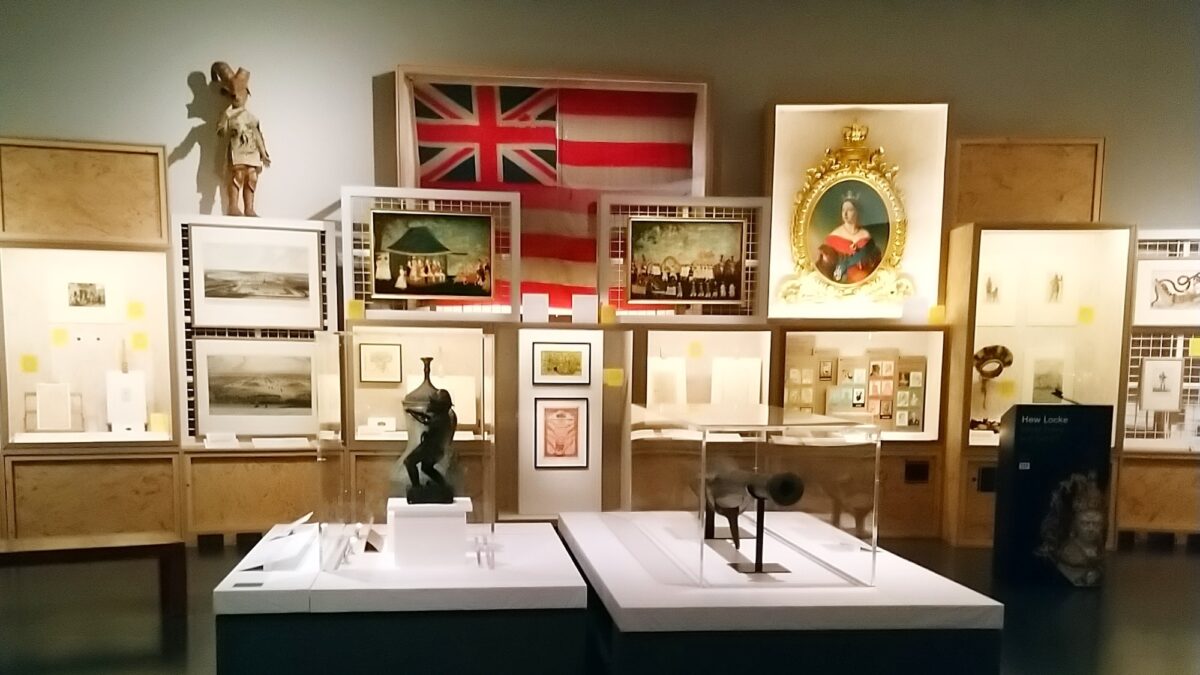
There’s a certain comfort in recognising the familiar figure and national colours, like meeting a long-lost friend in a traditional pub to reminisce about the good old times. Objects jostling for attention behind an excessive number of labels evoke a stuffy old museum rather than a contemporary art exhibition. On closer inspection these are no ordinary object labels, at least not only. The descriptions are an integral part of the curatorial concept and convey Locke’s thoughts and questions alongside the museum’s more pragmatic descriptions, inviting viewers to look behind the scenes and rethink prevailing narratives. Where title plates list dates and provenance, oversized post-it notes link objects to the humans that touched them, and to each other.
Just one example of the many stories that have their roots in the past and reach into the present and beyond are those linked to former West African currencies. These included shells and glass beads as well as the horseshoe shaped brass and bronze rings known as manillas. Britain benefited from access to the Indian Ocean as a source of cowrie shells, imported glass beads from Europe, and was able to mass produce manillas in Birmingham. All were exchanged for humans as part of the triangular trade. European goods paid for enslaved Africans who were forced to work on colonial plantations, with the spoils shipped back to Europe. As a final twist to the story, the manillas may have been melted down by the African traders who received them as payment and made into decorative plaques for their King’s palace; looted by the British Army many are held by the British Museum and are known as the Benin Bronzes.
To highlight their cultural significance, Locke describes two wooden sculptures as Jamaica’s equivalent to the Elgin Marbles, which are probably the most famous and most contested items at the museum. The indigenous people who carved the Jamaican figures no longer exist and the objects act as a symbol of collective memory that help Caribbean people to reclaim their heritage. As the wood may not have survived this long in the island’s tropical climate, they serve as an example of the museum’s traditional role of keeper and carer.
Another example of the complexities of ownership and repatriation is the famous Koh-i-Noor diamond. Taken from the deposed Maharaja of Lahore by the British East India Company in 1849, it became a symbol of the British Empire, was recut and eventually became part of the British Crown Jewels. Six countries currently have a claim to the diamond, with the Mughal Empire across India, Pakistan and Bangladesh the first in a succession of rulers, including the Afsharid dynasty in modern-day Iran, the Durrani Empire in Afghanistan, and India and Pakistan again with the Sikh Empire who surrendered the diamond to Queen Victoria – who comments Locke, at least had the good grace to feel a bit guilty about wearing it.
The East India Company serves as a powerful link to all four of the exhibition’s four themes of sovereignty, trade, conflict and treasure. A commercial company, it controlled an armed force bigger than the British Army to protect its economic extraction. Hew Locke asks us to imagine Amazon running its own army today.
Examples of his ongoing series of drawings on historical share certificates from companies that have since collapsed are displayed next to objects they would have traded in, while many companies whose financial power is based on colonial relationships may still be operational today. The Share Series spreads across the breadth of the British Empire and highlights links to the present. Examples include a jigsaw puzzle map of Africa covering Chinese Imperial Gold Loan 11 and a portrait of Mahadma Ghandi on a certificate for a Lancashire cotton mill.
The ghostly musicians walking across the Confederate States of America Loan resemble the characters in Locke’s recent installation at Tate Britain. Some of the participants seem to have split off The Procession to spread out and watch over the displays at the British Museum. Less ornately decorated and smaller than their predecessors, they hide in the shadows above the cabinets and are easily overlooked once you are absorbed in the exhibition below. The Watchers spill out of the exhibition and into the Enlightenment room that stretches across the entire length of the Great Court as one of the museum’s most prominent displays.
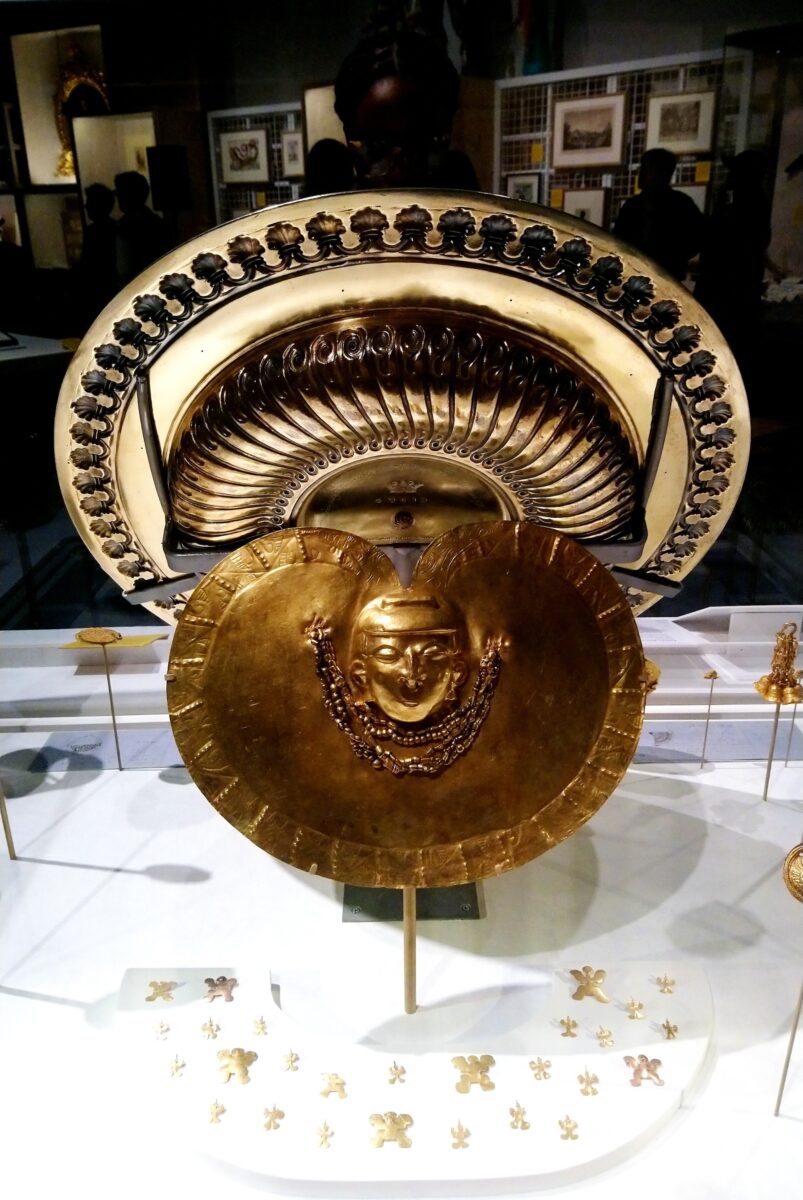
Sculptures are presented alongside the trophies and treasures, weapons and maritime paintings that inspired them, including three lavishly embellished Royal busts from Locke’s Souvenir series and a small selection of Armada boats. The symbolic significance of regalia and insignia is picked up again in a final case containing Hew Locke’s personal OBE and RA medals, underlining the complexity of British history and the artist’s personal entanglement.
The exhibition may be contained in just one room, but it demands attention. With no prescribed route, you find yourself zig zagging between cabinets as you make your own connections between art and history, regions or topics, re-reading the labels or taking a step back as you remember the presence of The Watchers.
What have we here? is a beautiful invitation to be both curious and critical, to ask and find answers.
Hew Locke, What have we here? – 9th February 2025
The British Museum
Tickets £16; concessions available; under 16s free (T&Cs apply) Exhibition catalogue £25
@britishmuseum hewlocke.net @hewdjlocke
